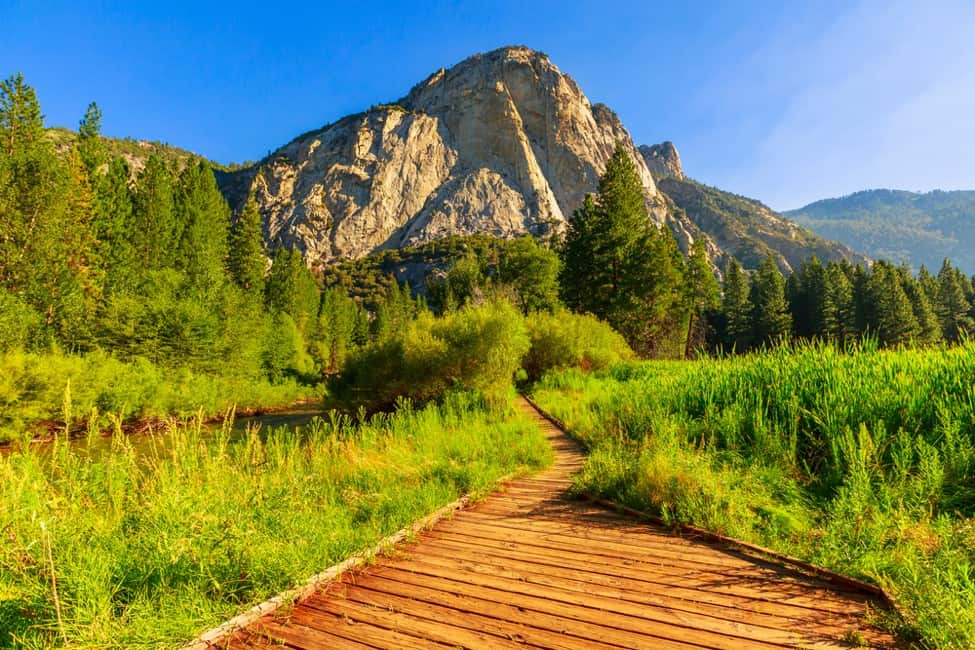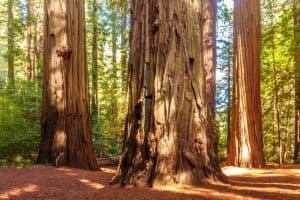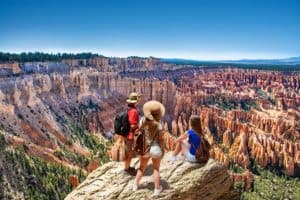Last Updated on October 10, 2024 by Aswetravel
Things To Do In Kings Canyon National Park is a go-to destination when looking for a site to explore in California. The park boasts an extensive mountain range, features the only living shrine in the nation, and is home to one of the deepest canyons in North America.
Despite these spectacular sites, this stunning park still comes second to its neighbor and frontrunner, Sequoia National Park. Visitors to the area should know that Kings Canyon stands on its own as an excellent destination that delivers at every turn.
So whether you decide to take a hike through the park or check out just one massive tree, Kings Canyon gives you a unique chance to visit a national park without having to worry about the crowds.
Things To Do In Kings Canyon National Park
Below are some of the enthralling experiences you can try out in Kings Canyon.
1. Take A Hike Or A Horse
Kings Canyon National Park covers 461,901 acres and provides ample opportunities to tour sequoias, waterfalls, mountain passes, lakes, and meadows.
There aren’t many trails, but those that are available in the park come with huge payoffs. The Roaring River Fall is a paved trail that is 0.3 miles long and leads to a powerful waterfall flowing through a granite shoot, and the Zumwalt Meadow is a 1.5-mile out-and-back trail with amazing views of rock formations, meadows, and the Kings River.
You need a wilderness permit to camp outside the designated campsites in Kings Canyon, where you’ll have access to longer, isolated wilderness trails.
There are in-park lodging arrangements if you prefer a night in a cozy bed after spending a day in nature. The Grant Grove Cabins and John Muir Lodge let you access all the amenities near General Grant, whereas the Cedar Grove Lodge is found deeper in Kings Canyon.
Alternatively, you can explore the park by guided horseback during the summer. These rides give visitors a once-in-a-lifetime experience in only one or two hours. You also have the company of an expert while on your journey, and backcountry options are available if you crave something more adventurous.
2. Drive to Cedar Grove
You can only access this site underneath Kings Canyon during the warm months when there isn’t any snow. The roadway to the Canyon usually opens in May, though you’ll have to confirm the current date details from the National Park site if you’re stopping by in fall or spring.
The ride into Kings Canyon is breathtaking, and you’ll want to stop at the scenic viewpoints along the path. Luckily, there are several sites along the road’s edge to pull off and check out the beautiful scenery. For safety reasons, it’s best not to cross traffic when pulling over to take in the view.
3. Go Deep
Kings Canyon is potentially the deepest canyon in North America. Even though it’s not as wide or as long as the Grand Canyon, glaciers did carve it, and it exceeds 8,000 feet deep in some areas.
The Kings River also winds its way dramatically through the canyon, and there are sites for summer beaches and fishing in many park areas. Those 16 years and above must get a California fishing permit.
You can also fly fish using an NPS-approved guided utility. There’s seasonal whitewater rafting outside the park, so feel free to add this to your adventure list and get an extra adrenaline dose during your trip.
4. Explore the Trail at General Grant Tree
This short track is at Grant Grove and leads to the giant General Grant Tree.
This giant tree is approximately 1700 years old and is one of the biggest trees on earth.
The ⅓-mile path to General Grant is made of asphalt, so it should take you less than an hour to reach the end and walk back.
Where possible, set aside time to tour the Fallen Monarch—a massive tree that fell that you can see inside of.

5. Listen to the Waterfalls Roar
You’ll find some remarkable waterfalls off the road along the drive into the park. The first waterfall you encounter when driving into the canyon is Grizzly Falls. For the best view, visit the site after the winter thaw in mid-May.
You can dash from one tree to another to get a clearer and closer look and take perfect pictures while staying dry since it produces a lot of mist.
There’s also a small picnic site near the waterfall bottom that makes it an excellent spot to catch a breath and snack if you bring food with you.
Roaring River Falls is slightly further down the path. These waterfalls are smaller but incredibly fascinating as they rage tremendously, especially during the spring. They become quieter during the summer but are still a sight to behold.
6. Camp at the Sequoia National Park
The best way to get the full experience of Kings Canyon National Park is by taking an overnight trip to nearby Sequoia National Park and camping in any one of the seven camping sites that are available.
The campgrounds found within the Sequoia and Kings Canyon park system include:
- Dorst Creek
- Cold Springs
- Lodgepole
- Potwisha
- Atwell Mill
- South Fork
- Buckeye Flat
Cold Springs and Atwell Mill campsites can only be accessed during the summer and aren’t connected to the main road in Sequoia National Park. Other camping sites are located near the neighboring forest land.
Whether you prefer a rugged experience or something more comfortable for your camping trip, the campsites in Sequoia National Park can accommodate your needs.
If you prefer camping in an RV, Potwisha campsite is the best for you. The campground has 24-feet long RVs with potable water, flushing toilets, and other necessities.
In comparison, you can go to the Buckeye Flat Campsite to connect with nature. The campground is strictly tent only and located beside Kaweah River.
Many who recently visited Sequoia National Park recommend carrying extra layers of clothing as the nights can become very cold.

7. Visit the Crescent Meadow
If you are looking for a serene environment where you can take in all the beauty of nature, Crescent Meadow is an excellent choice.
The Crescent Meadow encompasses massive Sequoia trees. You can access it by walking to the end of Crescent Meadow Road/Moro Rock, trekking through the Crescent Meadow Parking area, and carrying on to the 1.5-mile loop surrounding the dense field.
In the summer months, colorful wildflowers blossom here, and you can even spot animals like bears, marmots, and deers from the track. Maintain a safe distance from such wild animals as they tend to be aggressive when protecting their offspring.
If you want to take a leisurely trek and explore the breathtaking landscape of Crescent Meadow, you’re in luck. The hike is accessible to visitors of all ages, and you can go at your own pace while taking pictures of the beautiful scenery and animals you encounter.
According to reviews, the parking area at the trailhead is relatively small, so to secure a spot, get there early in the morning.
8. Have an Experience of the Mist Falls
Are you searching for a more demanding hike? Head over to the trail that leads to Mist Falls, situated at the Cedar Grove section.
To access the beginning of the track, drive until you reach the end of the tarmac. Park your vehicle at the parking lot on your right, then begin your hike at the Kanawyer Loop Track (the simplest section of the trek).
After the first three miles, the track becomes more challenging, particularly towards the South Fork River, which leads to the impressive waterfalls.
The altitude of the 8-mile trek is 820 feet. This hike is perfect if you want to spend the whole day exploring, but it’s not the best option if you’re pressed for time.

9. Check Out the Buck Rock Lookout
The lookout hike is the most difficult to reach, but you will be rewarded with a breathtaking view. It consists of a raised watchtower constructed in 1923.
The lookout was originally used to watch out for fires, so you can enjoy spectacular scenic views of both the Sierra Nevada mountains and the Great Western Divide from this spot.
The breathtaking views and the route to the peak draw people to this hike. To get to the viewing point (next to the granite peak), you will have to go up 172 dizzying steps.
Take General’s expressway toward Sequoia National Park to access the Buck Rock Lookout. The road that leads to Big Meadows is 8.3 miles from Kings Canyon Visitor Center. Turn left after 2.8 miles and drive for another two miles or walk to the crest where the lookout is. This hike is not recommended if you suffer from vertigo.
The Lookout is usually open till 5 pm, and the road is inaccessible in winter.
10. Visit the Boyden Cavern
Even though Boyden Cavern is not as popular as the Crystal Cave in Sequoia National Park, there are still some magnificent chambers filled with rock formations you can tour on a 45-minute paid visit (usually accessible from late April to September).
You don’t have to book tickets in advance. Just show up at the entry and wait for your turn.
The short ascending path that leads to the cave’s entrance is at the exclusive car park, 20 miles from the visitor center along the picturesque drive.
Start Planning Your Trip to Kings Canyon National Park
John Muir once referred to Kings Canyon as a rival Yosemite National Park because of its unique rock outcroppings, skyscraping trees, and deep valleys. Redwood Canyon, which is the largest remaining grove of Sequoia trees in the world, is found in Kings Canyon.
So why wait? Make arrangements to visit the park today.
Best Death Valley Hikes and Tips for Hiking Death Valley
Best Time to Visit Sequoia National Park
Kings Canyon National Park Camping
Best Time to Visit Joshua Tree National Park
Best Time to Visit Death Valley
Yosemite Hiking Trails
Best Time to Visit Yosemite
Best Time to Visit Lake Tahoe
Lassen Volcanic National Park Camping
Lassen Volcanic National Park Things To Do




